This is silky smooth, divinely creamy yet somehow light and fluffy. It’s nutty, tangy, bright, garlicky, mega fresh and SO flavorful, plus it’s healthy, vegan and loaded with protein! I honestly think it’s the best hummus recipe out there due to a few simple tips and tricks to create the smoothest, creamiest hummus. Plus, it’s super simple. All you need is a can of chickpeas, some tahini, olive oil, lemon juice, garlic and a food processor. I’ve also included 5 other hummus recipe variations – because one hummus recipe is never enough. Enjoy your homemade hummus with pitas, crunchy veggies or slather it on sandwiches or wraps. Now, get ready for the best, utterly creamy hummus of your life!
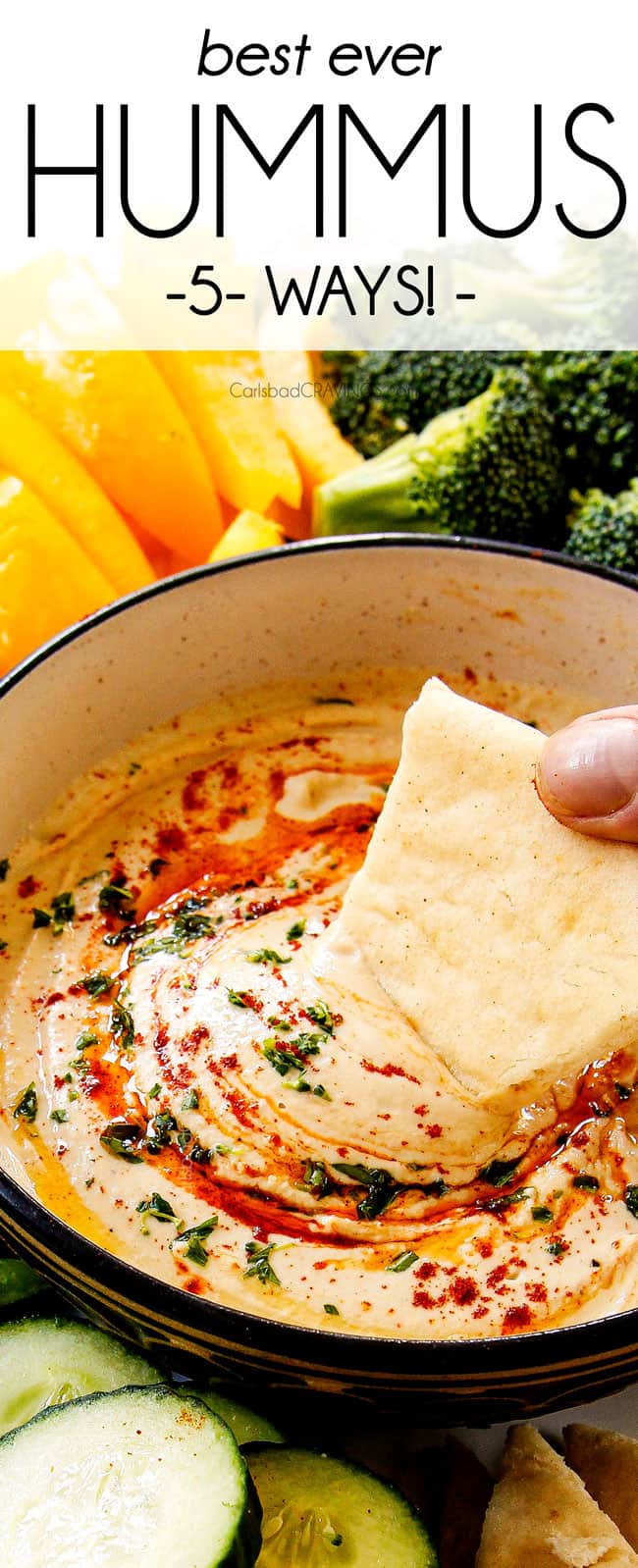
Oh hummus, how do I love thee? Let me count the ways….
What can’t you imagine your life without? Coffee? Diet Coke? Chocolate? For me, it’s hummus and tzatziki. I absolutely love hummus and am always dunking my veggies in hummus, slathering wraps with hummus or adding it to grain bowls.
In the past, I would always keep my fridge stocked with various tubs of hummus until I learned just how easy it is to make homemade hummus – and how much better it tastes. It’s not only uber fresh, lusciously smooth with a bright lemony garlic blend, but it’s made with just a handful of pantry friendly ingredients. This means you can make homemade hummus any time for the creamiest snack, or as a last-minute dip for movie night, backyard barbecues, parties or potlucks. Everyone will be raving about the recipe and wondering your secret to the creamiest every homemade hummus.
So, what is the secret to the tastiest, creamiest hummus recipe? After scouring the internet, reading all sorts of theories and claims and conducting my own experimenting and taste test after taste test, I’ve come up with a clear winner:
To arrive at this conclusion, I put several popular theories to the test from peeling individual chickpeas to using chickpeas straight out of the can, to Solmonov’s famous method of soaking dried chickpeas overnight and then boiling them in baking soda, to using canned chickpeas and boiling them with baking soda for 20 minutes, to overcooking chickpeas without the baking soda.
You would think peeling the chickpeas or boiling the chickpeas to a mush would produce promising results, but the hummus was dense and grainy. The only methods that blended into a silky, creamy, light, whipped texture were: 1) soaking dried chickpeas and boiling with baking soda and 2) boiling canned chickpeas with baking soda for 20 minutes.
The baking soda breaks down and softens the texture of the chickpeas so they are ready to blend into the silkiest hummus on the planet. The two methods were both SO unbelievably creamy and, in all honesty, practically indistinguishable from each other. So, in my opinion, it’s not worth using dried chickpeas for the best homemade hummus recipe.
Now that the hummus was ready to blend, I discovered that processing them for a full 4 minutes was another game changer. Two batches of hummus can be prepared exactly the same way and the one processed for longer will win every time.
Armed with this knowledge, I set off to tackle other theories such using ice verses ice water, adding tahini first or with the chickpeas and of course, the quantities of ingredients. My results are in this hummus recipe. I hope you love it as much as we do!
You can read on or use the “jump to recipe” button at the top of the post to skip to the hummus recipe.
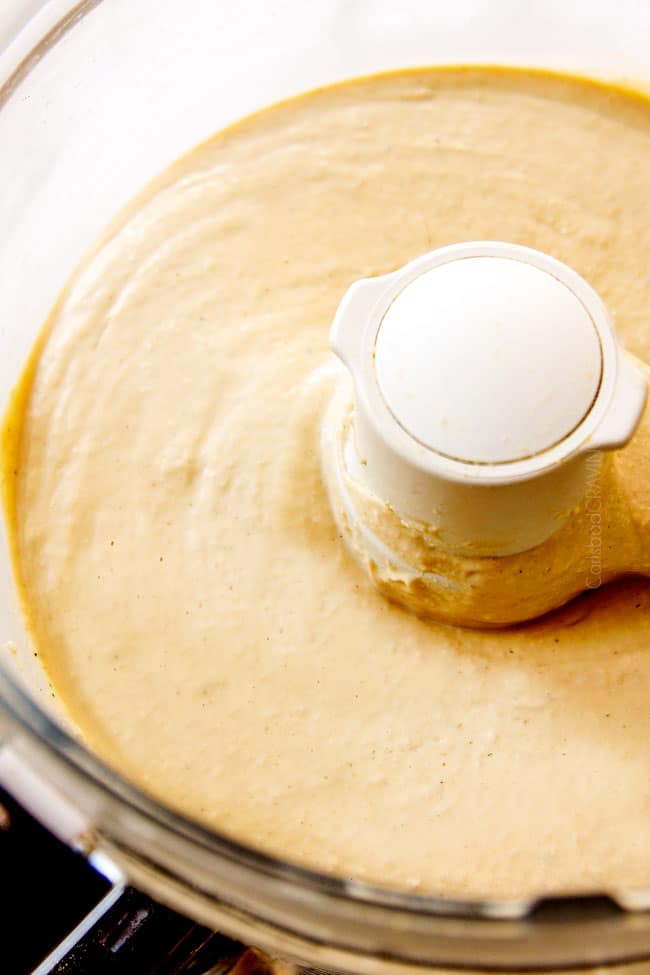
If you have never made homemade hummus before, you might be surprised how few ingredients it requires. Most of the ingredients can be found in your pantry right now, and if not, they are easy to stock which makes hummus the perfect last-minute dip for potlucks, backyard barbecues, game day or just a family snack. You will need:

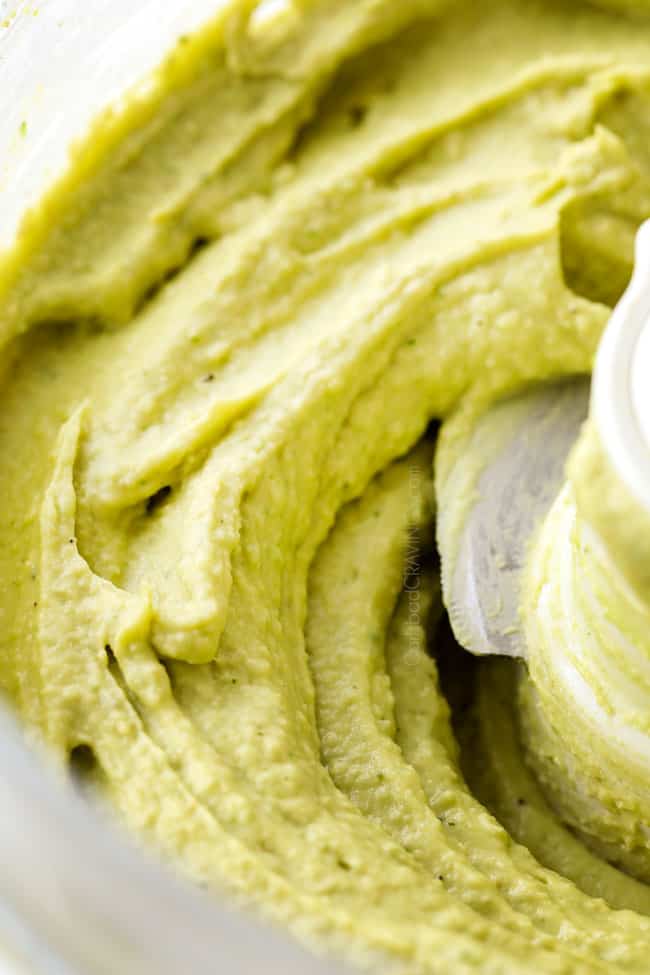
Homemade tahini is easy to make and less expensive than store-bought if you purchase the sesame seeds in bulk. I recommend hulled sesame seeds as opposed to unhulled or sprouted. This homemade tahini recipe yields approximately ½ cup and can be kept in the refrigerator for one month. It is also easy to double and triple.
This homemade hummus recipe is SO easy to make, you’ll have it on weekly repeat! Here is my step by step guide for how to make hummus with photos. You will find the ingredient measurements in the printable recipe at the bottom of the post.
For any of the above cooking methods, if you don’t use the cooked chickpeas immediately, store them in their water/juice (just like canned chickpeas) in an airtight container; refrigerate for up to 5 days.
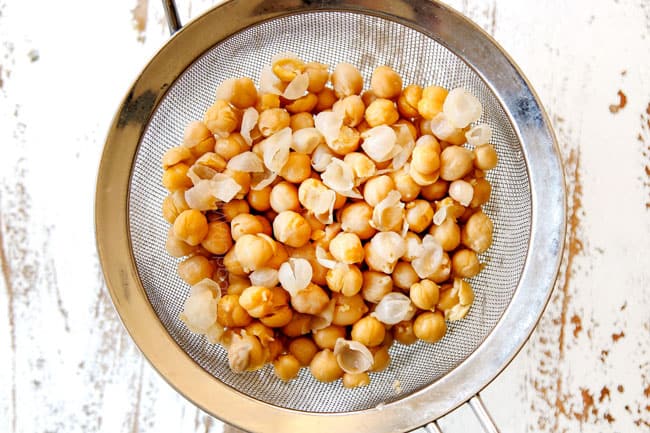
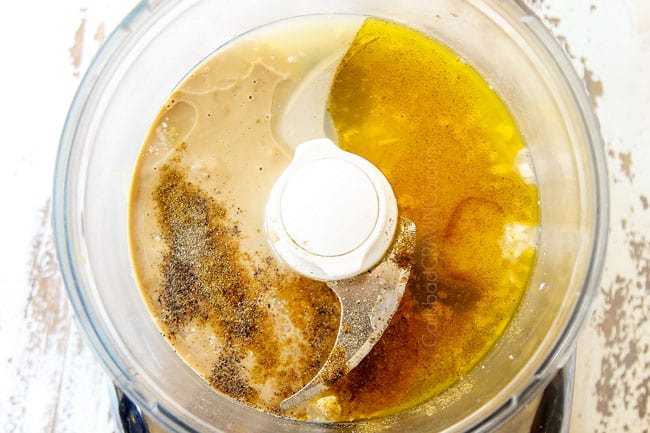
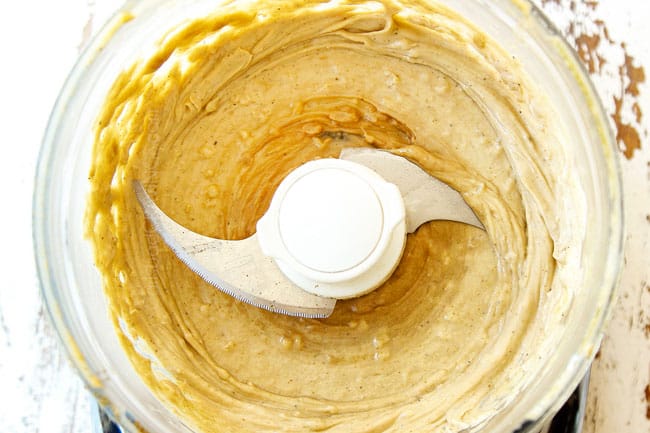
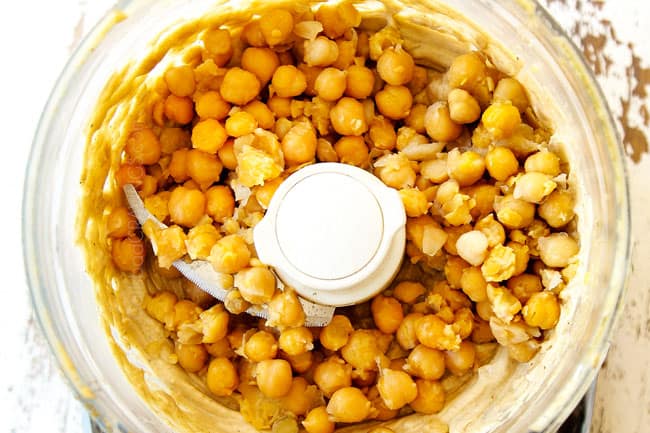

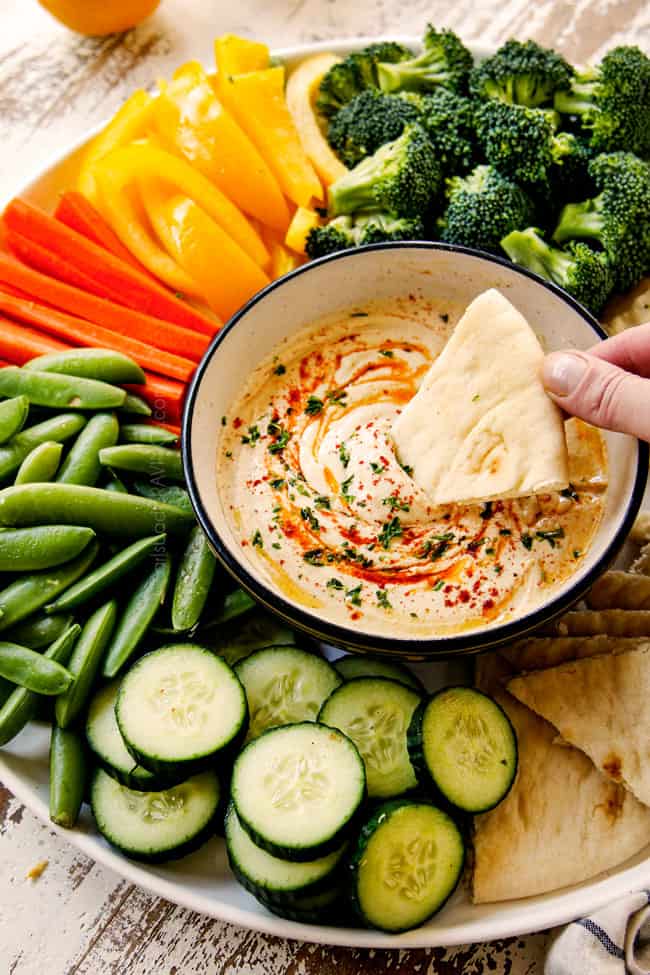
Homemade hummus is wonderfully simple with just a few ingredients. This means it is important to use quality ingredients and the best techniques. Read on for a few tips and tricks that will transform your hummus recipe from ordinary to extraordinary.
Cooking either your canned or dried chickpeas with baking soda until almost mushy is the #1 tip for the creamiest homemade hummus.
The baking soda softens the chickpeas and helps the skins slough right off of the chickpeas as they cook. This means you don’t have to painstakingly peel each chickpea – it’s okay to leave whatever skins don’t pop off by themselves. Note that the baking soda is key here, you can’t just simmer chickpeas until mushy and expect the same luxuriously smooth results. An added bonus of baking soda is it can help reduce gas and bloating – win, win!
Some brands of canned chickpeas are harder than others, so don’t limit yourself to simmering them for 20 minutes. Cook the chickpeas until they are soft and the skins are popping off. It is better to “overcook” the chickpeas than undercook them.
Peeling the chickpeas is a game changer to create extra smooth hummus. Although you don’t have to peel each chickpea thanks to the baking soda, it is ideal to remove as many of the skins as possible.
The baking soda will cause many of the skins to slough right off. If you don’t see a bunch of skins after you’ve simmered your chickpeas- it means you haven’t cooked them long enough. Cook until you see a bunch of scaly looking skins. Pick these noticeable skins out before you rinse the chickpeas.
After you’ve picked over the chickpeas, rub them in between your fingers as you rinse them. This will quickly remove most of the remaining skins.
All tahini is not created equal. Unfortunately, tahini spans a wide range of flavor and quality. Some are more oily, nutty, pasty or bitter. I’ve had hummus so bitter it’s ruined my hummus – so choose wisely! The variances come from the type of sesames seed used, how they are processed and how they are roasted. Some sesame seeds have a higher oil-to-meat content which yields richer tahini, some seeds are left unhulled which yields more bitter, grittier tahini, some are roasted more which results in stronger-tasting tahini. In additional, some brands contain additives such as oil, salt sugar, and even coloring.
So how do you know which tahini to purchase? It is actually quite simple. Tahini made from 100% roasted and pressed organic Ethiopian white Humera sesame seeds is considered the gold standard.
Humera sesame seeds are named after Humera, a small town in Ethiopia. They are one of the most sought-after sesame seed types in the world due to their white color, favorable aroma, high oil content, incomparable richness and reliable nutty and sweet flavor. They are also hand-harvested in small amounts for consistent quality.
My favorite brand of tahini is Soom. There is almost no competition to be honest. It is made from 100% Humera sesame seeds, is velvety smooth, and boasts a clean, rich, nutty flavor with the ideal hint of bitterness. Soom tahini will elevate your hummus to the next level. It is pricier than others, but is the epitome of getting what you pay for. You can find Soom tahini on Amazon here as well as some specialty stores and Whole Foods. It is SO worth the purchase. (Note Soom also has chocolate tahini-drool )
Other tahini brands made from Humera sesame seeds include Seed & Mill and Pepperwood Tahini (they have two kinds, so look for “Organic Ethiopian Hulled Sesame Tahini”).
If you don’t want spend quite as much money on tahini, you can still find quality tahini made from 100% sesame seeds, even if they aren’t Humera sesame seeds. Here is what to look for:
Tahini can last for up to 6 months if refrigerated, but you’ll still want to check and make sure your tahini is fresh. If your tahini has been sitting around longer than that, it’s best to toss it because the sesame oil can become rancid over time. If you use rancid tahini without knowing it, your homemade hummus will taste terrible, not to mention you’ve wasted time and ingredients.
Depending on your brand and age of tahini, you will notice that some of the solids and oil will have separated, similar to natural peanut butter. You will want to stir the tahini until it’s completely incorporated before scooping out so you don’t get mostly oil or all solids. If your tahini is extra difficult to stir, empty it into a bowl to mix.
You will be amazed at what this simple step does to elevate your hummus recipe! No matter what variation of homemade hummus you make, always process the tahini first with whatever additional add-ins before adding the chickpeas. This will whip the tahini into a smooth, rich, creamy paste while aerating the ingredients to create lighter, fluffier hummus.
This tip is HUGE! After you add the chickpeas, let the food processor run for a solid 4 to 5 minutes.The longer you process the hummus, the smoother it will become, it’s as simple as that. For the most intoxicatingly creamy hummus, blend for the full 5 minutes.
There are several ways to make hummus creamier:
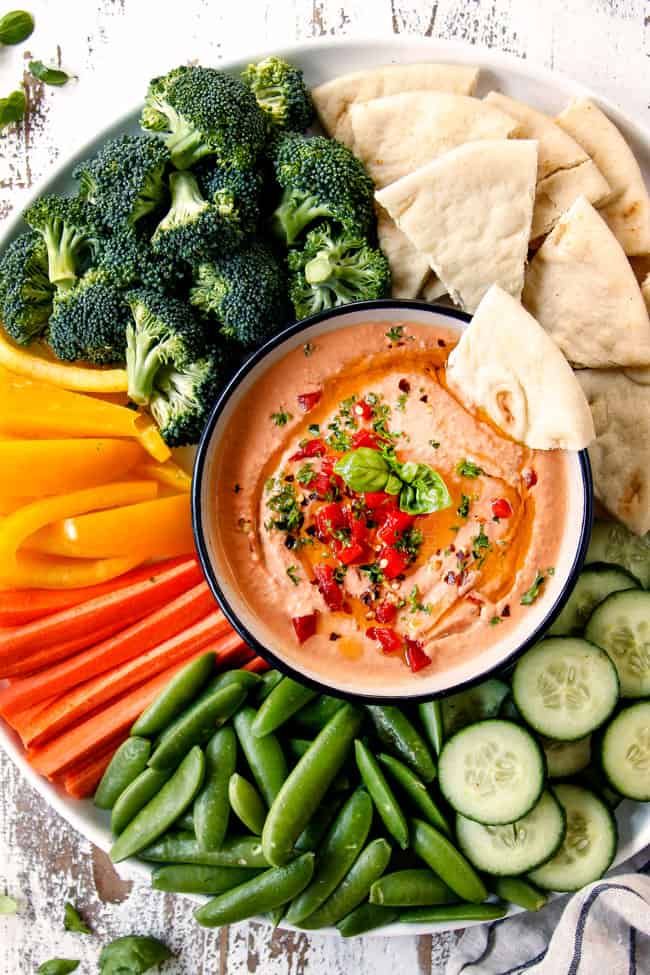
There are countless variations of hummus because hummus is a chameleon of sorts when it comes to flavorings and tastes amazing with practically everything. My favorite remains this traditional homemade hummus recipe, but don’t let that keep you from experimenting. I’ve also included recipes for my other favorite variations: sun-dried tomato hummus, roasted, red pepper hummus, pesto hummus and avocado hummus.
In addition to trying these hummus recipes (section below), you can also blend any of the following into your homemade hummus when you add the tahini, before adding the chickpeas:
You can completely change the flavor profile of your hummus by adding different seasonings. Here are just a few options:
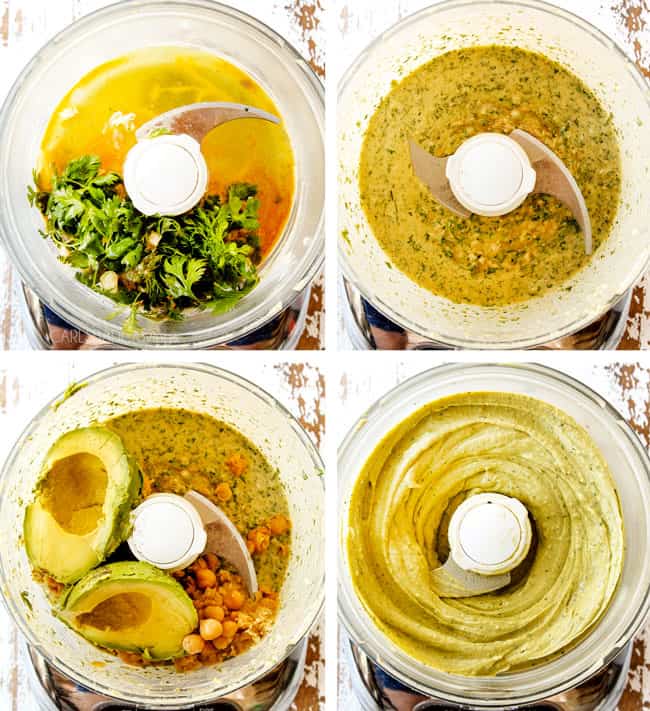
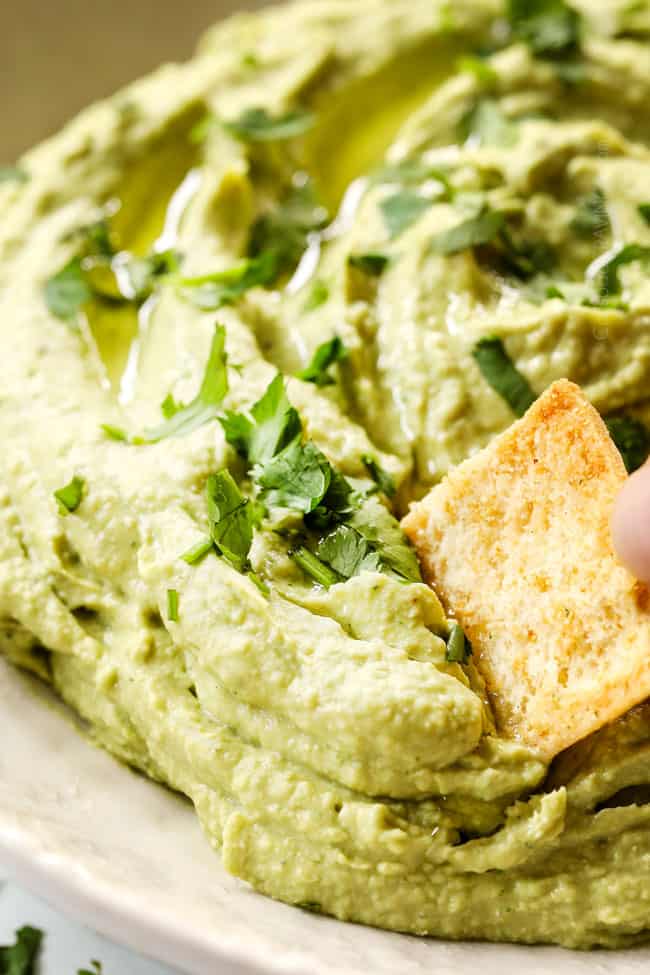
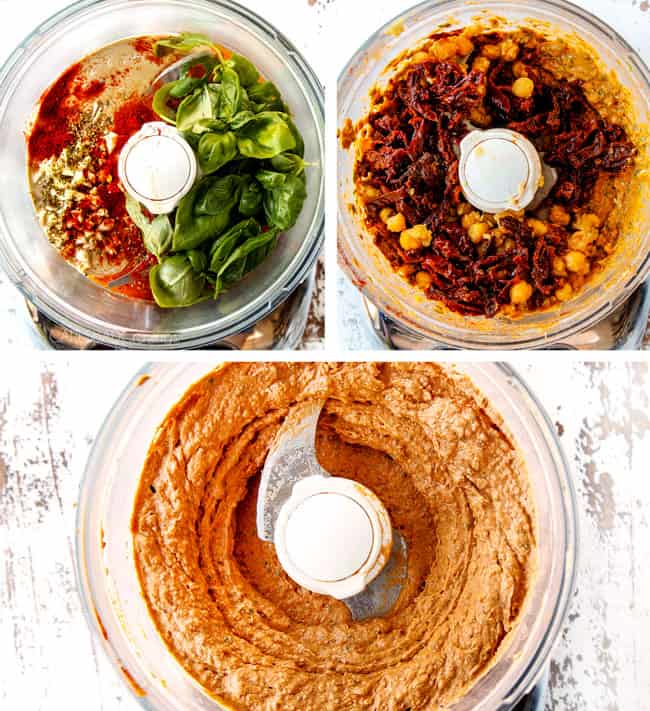
:

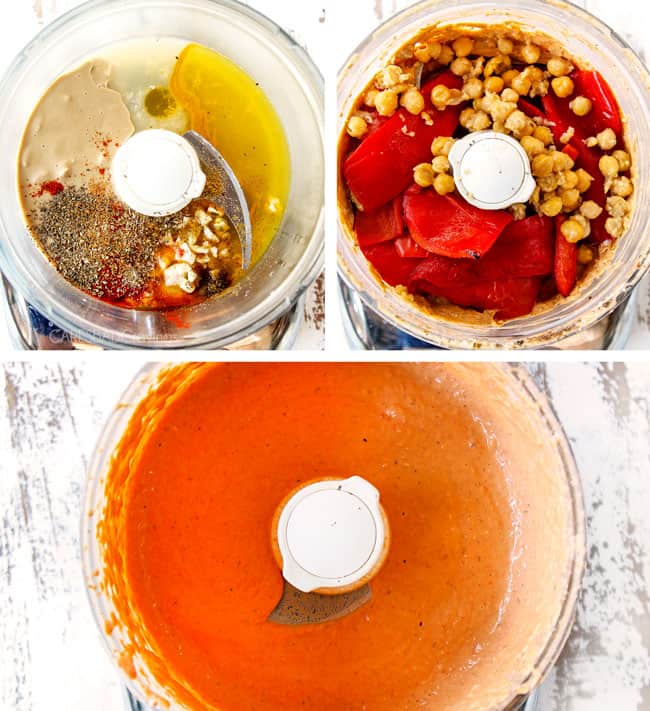
HOW TO ROAST PEPPERS
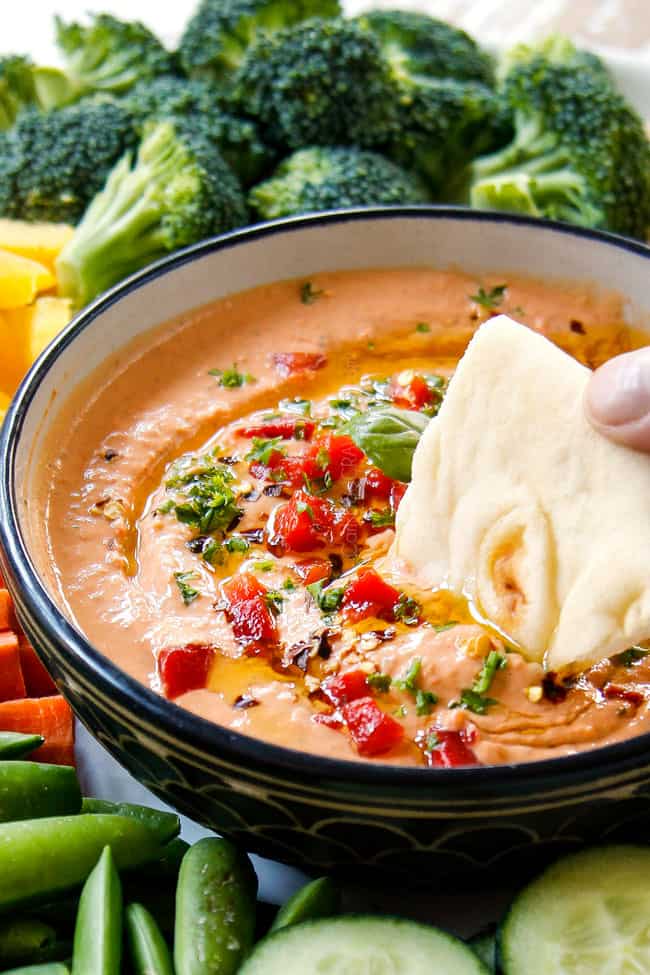
Note we don’t add tahini because we are adding pine nus or walnuts instead.

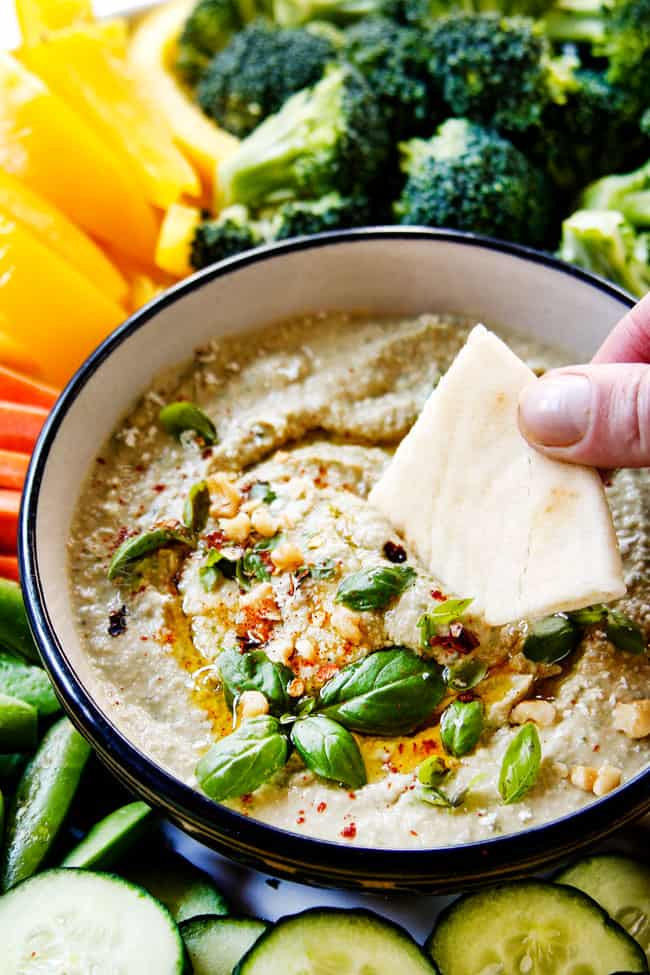
Homemade hummus is sensational as a dip for pitas, pita chips, and veggies. I can eat 10X more veggies when I’m dunking them in hummus – it’s just so good! Serve hummus with any of the following or make it the center of your crudité board and surround it with all of the following:
Hummus is delicious with just a drizzle of olive oil, but even more fabulous with a few simple garnishes. Here are some to choose from:
If for some reason your hummus ends up thinner than you like, you can add additional tahini or stir in a couple tablespoons of Greek yogurt. Chilling the hummus will also thicken it up a bit.
Hummus a protein powerhouse, loaded with protein, fiber and nutrients. Here are just a few benefits:
hummus is a great source of plant-based protein at 7.9 grams per serving. It is an excellent way to meet your protein intake, especially if you follow a vegetarian or vegan diet. Protein is an essential building block of your bones, muscles, cartilage, skin, hair, nails and blood. Your body needs protein to heal from everyday wear and tear as well as relieve muscle aches and build muscle.
chickpeas are loaded with insoluble fiber which is essential for gut health. Fiber keeps your digestive track moving food along (AKA preventing or relieving constipation). Insoluble fiber can also help lower “bad” cholesterol, lower the risk of colorectal cancer, lower the risk of diabetes and heart disease.
hummus provide a wide variety of vitamins and minerals including iron, manganese, folate, zinc, phosphorus and B vitamins:
is needed to carry oxygen from the lungs to all parts of the body. Your body also needs iron to make some hormones and keep your hair, skin and nails healthy. If you do not have enough iron, you won’t have healthy oxygen circulation, which will cause fatigue and grogginess.
is considered an essential nutrient required for aiding in metabolism, bone formation, regulating blood sugar, decreasing inflammation and immune response.
are two B complex vitamins that the body needs to support cellular functions such as dividing cells and breaking down carbohydrates, proteins and fats to produce energy. These vitamins also help your body build red blood cells which allows oxygen to be used by the body.
is vital for a healthy immune system, correctly synthesizing DNA, and healing wounds.
forms and strengthens bones and teeth. It also helps produce ATP, a molecule the body uses to store energy.
helps to lower blood pressure and combat heart disease. It also supports heart and muscle function and may reduce the risk of developing kidney stones and help to decrease bone loss.
Chickpeas have a fair amount of carbs at 78 grams in one 15 oz. can, or 4 grams in 1 tablespoon. The actual carb count of your hummus will reduce slightly with the addition of tahini, lemon juice, etc.
No, traditional hummus made with chickpeas is not keto because chickpeas are legumes which contain carbs and little fat.
Yes, you can definitely make hummus up to 3 days in advance. In fact, allowing hummus to sit in the refrigerator for a few hours or overnight can often enhance its flavors. Store it in an airtight container and give it a good stir before serving.
Yes, hummus can have anti-inflammatory properties due to its ingredients like chickpeas, olive oil, and various spices. Chickpeas contain nutrients that may help reduce inflammation, and olive oil contains compounds with potential anti-inflammatory effects.
Hummus is primarily a source of carbohydrates, as it is made from chickpeas, which are a legume rich in carbohydrates. While chickpeas do contain some protein, the protein content in hummus is relatively moderate compared to its carbohydrate content.

You can now create an account on our site and save your favorite recipes all in one place!
See post for step by step instructions, tips and tricks, how to use and cook dried chickpeas, the best tahini brand, and more recipe variations than listed below.
- Pinch red pepper flakes
- 1 15 oz. can chickpeas, rinsed, drained cooked
- 2 ice cubes
- Add all the ingredients to your food processor except chickpeas and ice; puree until very smooth, about 3 minutes.
- Add chickpeas and ice cubes and process for 4 minutes, no less! Once completely smooth, add ice water, one tablespoon at a time, if needed, to thin to desired consistency.
- Season with additional salt and lemon juice to taste.
- Garnish with extra olive oil and a sprinkling of chopped fresh herbs.
- ¼ cup well-stirred tahini
- ¼ cup fresh basil
- 3 tablespoons fresh lemon juice
- 2 tablespoons oil from sun-dried tomato jar
- 2 garlic cloves peeled
- ¾ teaspoon salt plus more to taste
- ¼ tsp EACH dried oregano, dried parsley, smoked paprika, red pepper flakes
- 1 15 oz. can chickpeas, rinsed, drained cooked
- ¾ cup drained oil-packed sun-dried tomatoes (6.7-ounce jar, drained)
- 2 ice cubes
- Add all the ingredients to your food processor except chickpeas, sun-dried tomatoes and ice cubes; puree until very smooth, about 3 minutes.
- Add chickpeas, sun-dried tomatoes and ice cubes and process for 4 minutes, no less! Once completely smooth, add ice water, one tablespoon at a time, if needed, to thin to desired consistency.
- Season with additional salt and lemon juice to taste.
- ¼ cup well-stirred tahini
- ¼ cup fresh lemon juice
- 2 tablespoons extra virgin olive oil
- 2 garlic cloves peeled
- ½ tsp EACH smoked paprika, dried basil, salt
- ¼ tsp EACH ground cumin, dried oregano
- Pinch cayenne pepper
- 2 whole red bell peppers (substitute about ¾ cup jarred roasted red peppers)
- 1 15 oz. can chickpeas, rinsed, drained cooked
- Add all the ingredients to your food processor except chickpeas and roasted red peppers; puree until very smooth, about 3 minutes.
- Add chickpeas, red peppers and process for 4 minutes, no less! Once completely smooth, add ice water, one tablespoon at a time, if needed, to thin to desired consistency.
- Season with additional salt and lemon juice to taste.
- Garnish with extra olive oil and a sprinkling of chopped fresh herbs.
- Move an oven rack so that it is about 5 inches from the broiler. Turn oven broiler on.
- Remove core of peppers then cut into large flat pieces. Arrange pepper pieces, skin-side up, on a baking sheet. Broil 5 to 10 minutes until the peppers skin has charred.
- Add peppers to a resealable plastic bag, seal then wait 10 to 15 minutes until cool enough to handle. Or, add peppers to a bowl then cover with plastic wrap and wait 10 to 15 minutes. Gently peel away the charred pepper skin and discard. Reserve 1 to 2 pieces of the peeled roasted pepper pieces to use as a garnish when serving then roughly chop the rest.
Did You Make This Recipe?
Tag @CarlsbadCravings and Use #CarlsbadCravngs
Leave a Review, I Always Love Hearing From You!
Carlsbad Cravings© Original











